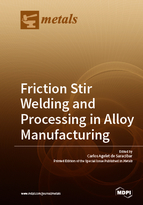Friction Stir Welding and Processing in Alloy Manufacturing
A special issue of Metals (ISSN 2075-4701).
Deadline for manuscript submissions: closed (31 January 2019) | Viewed by 45669
Special Issue Editor
Interests: computational mechanics; computational plasticity; contact mechanics; coupled thermomechanical problems; finite element method
Special Issues, Collections and Topics in MDPI journals
Special Issue Information
Dear Colleagues,
The computational modeling and numerical simulation of friction stir welding processes has been a very active field of research in the last few decades. Significant advances in this field have been achieved as a result of interdisciplinary research on related fields of computational mechanics, constitutive modeling, materials characterization, mathematical analysis, and numerical methods. On the other hand, also during this period, industry has shown a growing interest in incorporating numerical techniques as a valuable tool for design and process optimization.
This Special Issue on “Friction Stir Welding and Processing in Alloy Manufacturing” intends to collect the last developments in the field, written by well-known researchers who have contributed significantly in the computational modeling, numerical simulation, or material characterization of friction stir welding processes in alloy manufacturing.
Topics addressed in this Special Issue may include, but are not limited to:
- Computational modelling and numerical simulation
- Thermomechanical formulation
- Material properties
- Metallurgical characterization
- Numerical methods
- Industrial applications
Prof. Carlos Agelet de Saracibar
Guest Editor
Manuscript Submission Information
Manuscripts should be submitted online at www.mdpi.com by registering and logging in to this website. Once you are registered, click here to go to the submission form. Manuscripts can be submitted until the deadline. All submissions that pass pre-check are peer-reviewed. Accepted papers will be published continuously in the journal (as soon as accepted) and will be listed together on the special issue website. Research articles, review articles as well as short communications are invited. For planned papers, a title and short abstract (about 100 words) can be sent to the Editorial Office for announcement on this website.
Submitted manuscripts should not have been published previously, nor be under consideration for publication elsewhere (except conference proceedings papers). All manuscripts are thoroughly refereed through a single-blind peer-review process. A guide for authors and other relevant information for submission of manuscripts is available on the Instructions for Authors page. Metals is an international peer-reviewed open access monthly journal published by MDPI.
Please visit the Instructions for Authors page before submitting a manuscript. The Article Processing Charge (APC) for publication in this open access journal is 2600 CHF (Swiss Francs). Submitted papers should be well formatted and use good English. Authors may use MDPI's English editing service prior to publication or during author revisions.
Keywords
- Friction Stir Welding (FSW)
- Friction Stir Processing (FSP)
- Computational Modeling
- Numerical Simulation
- Finite Elements
- Material Properties
- Metallurgical Characterization






